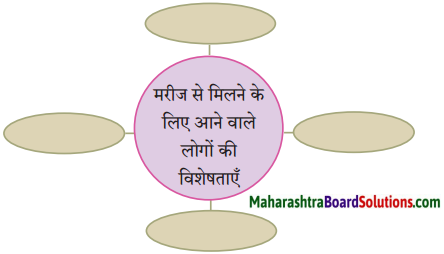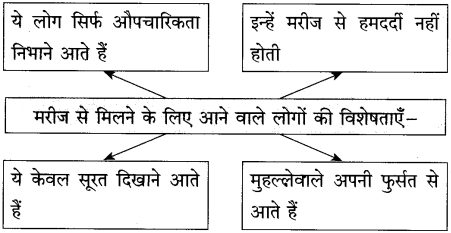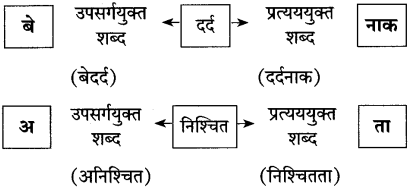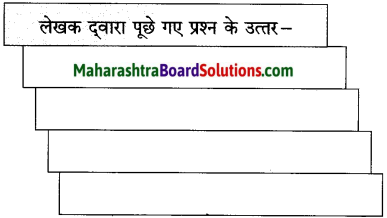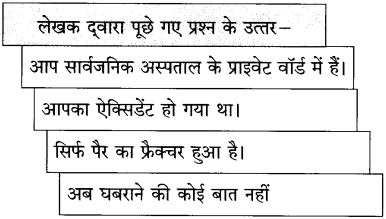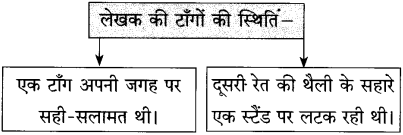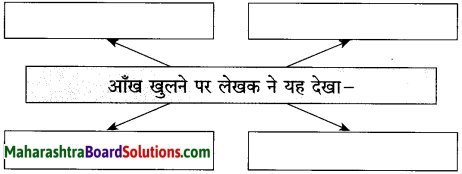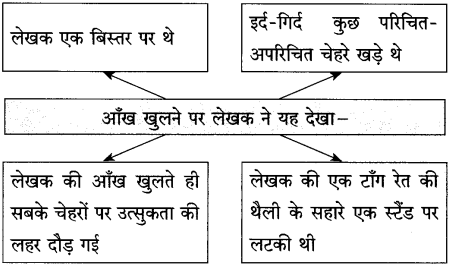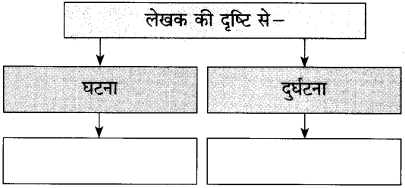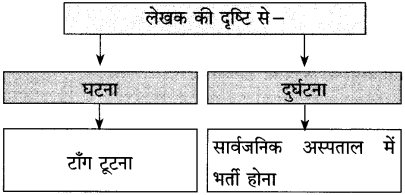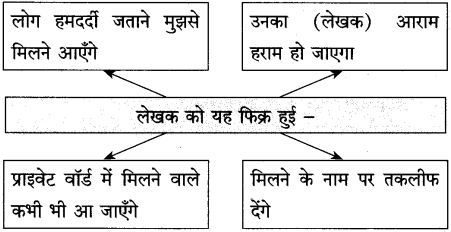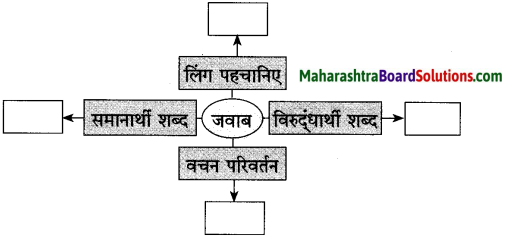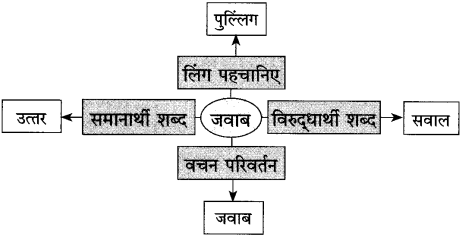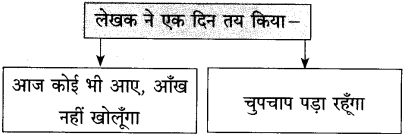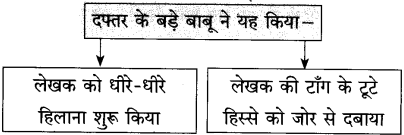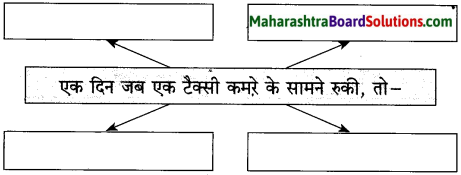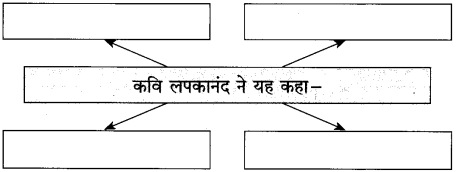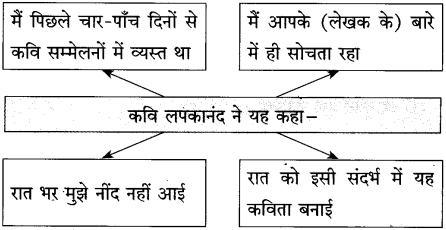Std 10 Hindi Chapter 5 Goa Jaisa Maine Dekha Question Answer Maharashtra Board
Balbharti Maharashtra State Board Class 10 Hindi Solutions Lokbharti Chapter 5 गोवा जैसा मैंने देखा Notes, Textbook Exercise Important Questions and Answers.
Hindi Lokbharti 10th Digest Chapter 5 गोवा जैसा मैंने देखा Questions And Answers
Hindi Lokbharti 10th Std Digest Chapter 5 गोवा जैसा मैंने देखा Textbook Questions and Answers
कृति
सूचना के अनुसार कृतियाँ कीजिए:
प्रश्न 1.
प्रवाह तालिका पूर्ण कीजिए:
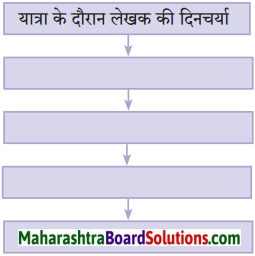
उत्तर:
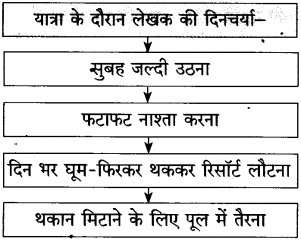
प्रश्न 2.
कृति पूर्ण कीजिए:

उत्तर:

प्रश्न 3.
लिखिए
a. नीले पानीवाला पथरीला –
b. रेतीला तथा उथला –
c. सबसे लंबा –
d. मछुआरों की पहली पसंद –
उत्तर:
(i) नीले पानीवाला पथरीला – अंजुना बीच
(ii) रेतीला तथा उथला – बेनालियम बीच
(iii) सबसे लंबा – कलिंगवुड बीच
(iv) मछुआरों की पहली पसंद – बेनालियम बीच।
प्रश्न 4.
सूची बनाइए:
| गोवा का प्राकृतिक सौंदर्य दर्शाने वाले वाक्य | |
| १. | |
| २. | |
| ३. | |
| ४. | |
उत्तर:
| गोवा का प्राकृतिक सौंदर्य दर्शाने वाले वाक्य | |
| (i) | हरीतिमा से भरपूर |
| (ii) | खूबसूरत सफेद रेतीले समुद्र तट |
| (iii) | चंद्रमा की चाँदनी में नहाया समुद्र |
| (iv) | गहरा नीला पानी। |
प्रश्न 5.
कृति पूर्ण कीजिए:
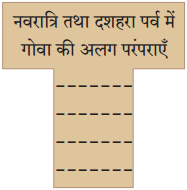
उत्तर:
(1) नवरात्रि की परंपराएँ –
(i) घरों में, गली-मोहल्लों में माँ दुर्गा की घटस्थापना।
(ii) लड़कियों द्वारा गरबा का पर्व मनाना।
(ii) दशहरा की परंपराएँ –
(1) सुबह लोग अपने वाहनों की सफाई करके उनकी पूजा करते हैं।
(2) शाम को भगवान की एक पालकी मंदिर ले जाई जाती है और लोग एक विशेष पेड़ की पत्तियाँ तोड़कर एक-दूसरे को देकर बधाई देते हैं।
प्रश्न 6.
‘बेनालिया’, ‘अंजुना’ तथा ‘कलिंगवुड’ बीच की विशेषताएँ:

उत्तर:
बेनालियम –
(1) यह बीच उथला और रेतीला है।
(2) यहाँ सुबह-सुबह बड़ी मात्रा में मछलियाँ पकड़ी जाती हैं।
(3) यह बीच मछुआरों की पहली पसंद है।
अंजुना –
(1) यह गहरा और नीले पानीवाला खूबसूरत बीच है।
(2) इस पथरीले बीच के एक ओर लंबी-सी पहाड़ी है।
(3) यह बीच बॉलीवुड की पहली पसंद है। यहाँ कई हिट फिल्मों की शूटिंग हुई है।
कलिंगवुड –
(1) यह काफी रेतीला बीच है।
(2) यह बीच 3 से 4 किमी. तक फैला हुआ है।
(3) यह गोवा का सबसे लंबा बीच है।
![]()
प्रश्न 7.
सोचिए और लिखिए:
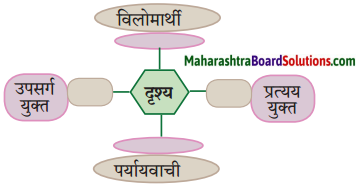
उत्तर:

अभिव्यक्ति-
प्रकृति को सुंदर बनाए रखने में मेरा योगदान’ विषय पर अपने विचार लिखिए।
उत्तर:
हम इस ब्रह्मांड के सबसे सुंदर, हरियाली से युक्त और बेहद आकर्षक ग्रह धरती पर निवास करते हैं। प्रकृति हम इन्सानों को ईश्वर द्वारा दिया गया सबसे खूबसूरत उपहार है। सुंदर पुष्प, आकर्षक पक्षी, वनस्पति, नीला आकाश, भूमि, समुद्र, जंगल, पर्वत, पठार, सूरज, चाँद इस सुंदर प्रकृति का हिस्सा हैं। स्वस्थ जीवन के लिए प्रकृति बहुत आवश्यक है। मैं इस बात का सदा ध्यान रखता हूँ कि यथासंभव प्रकृति की रक्षा कर सकूँ। मैं जब भी बाहर पार्क या बगीचे में जाता है, अनावश्यक रूप से किसी भी फूल-पत्ते को नहीं तोड़ता।
वहाँ खेलते हुए बच्चों को भी फूल-पत्ते तोड़ने से मना करता हूँ, उन्हें समझाता हूँ। मैं एक स्काउट लीडर हूँ। प्रकृति को बचाने के लिए लोगों में जागरूकता फैलाने का प्रयास करता हूँ। अन्य स्काउट्स के साथ मिलकर रैली निकलवाता हूँ कि घर के बाहर कचरा न फैलाएँ, प्लास्टिक की थैलियों के स्थान पर कपड़े के थैलों का प्रयोग करें।
भाषा बिंद
प्रश्न 1.
कोष्ठक में दी गई संज्ञाओं से विशेषण संलग्न हैं। नीचे दी गई सारिणी में संज्ञा तथा विशेषणों को भेदों सहित लिखिए: [भयभीत गाय, नीला पानी, दस लीटर दूध, चालीस छात्र, कुछ लोग, दो गज जमीन, वही पानी, यह लड़का]
| संज्ञा | भेद | विशेषण | भेद |
| …………………………. …………………………. …………………………. …………………………. …………………………. |
…………………………. …………………………. …………………………. …………………………. …………………………. |
…………………………. …………………………. …………………………. …………………………. …………………………. |
…………………………. …………………………. …………………………. …………………………. …………………………. |
उत्तर:
| संज्ञा | भेद | विशेषण | भेद |
| (1) गाय | जातिवाचक | भयभीत | गुणवाचक |
| (2) पानी | द्रव्यवाचक | नीला | गणवाचक |
| (3) दूध | द्रव्यवाचक | दस लीटर | परिमाणवाचक |
| (4) छात्र | जातिवाचक | चालीस | संख्यावाचक |
| (5) लोग | समूहवाचक | कुछ | सार्वनामिक |
| (6) जमीन | जातिवाचक | दो गज | परिमाणवाचक |
| (7) पानी | द्रव्यवाचक | वही | सार्वनामिक |
| (8) लड़का | जातिवाचक | यह | सार्वनामिक |
![]()
प्रश्न 2.
उपर्युक्त संज्ञा-विशेषणों की जोड़ियों का स्वतंत्र वाक्यों में प्रयोग कीजिए।
उत्तर:
(i) भयभीत गाय – लाठियों के डर से भयभीत गाय इधर-उधर दौड़ रही थी।
(ii) नीला पानी – झील का नीला पानी चाँद की रोशनी में चमक रहा था।
(iii) दस लीटर दूध – हमारी गाय दोनों समय दस लीटर दूध देती है।
(iv) चालीस छात्र – स्वाति की कक्षा में चालीस छात्र हैं।
(v) कुछ लोग – छत पर कुछ लोग चहलकदमी कर रहे हैं।
(vi) दो गज जमीन – औरंगजेब सारी उम्र युद्ध करता रहा। अंत में उसे अपनी दिल्ली में दो गज जमीन भी नहीं मिली।
(vii) वही पानी – यह वही पानी है, जो कल भरा था।
(viii) यह लड़का – यह लड़का चोर नहीं है।
प्रश्न 3.
पाठ में प्रयुक्त विशेषणों को ढूँढ़कर उनकी सूची बनाइए।
उत्तर:
- समुद्री
- खूबसूरत
- सफेद
- सांस्कृतिक
- शांत
- शीतल
- स्थानीय
- रोमांचक
- सुस्वादु
- शाकाहारी।।
प्रश्न 4.
निम्नलिखित वाक्यों में आई हुईं सहायक क्रियाओं को अधोरेखांकित कीजिए तथा उनका अर्थपूर्ण वाक्यों में प्रयोग कीजिए:
(i). टैक्सी एक पतली-सी सड़क पर दौड़ पड़ी।
वाक्य = ……………………………..
(ii). शरीर को कुछ समय के लिए विश्राम मिल जाता है।
वाक्य = ……………………………..
(iii). हम आराम करने के इरादे से अपने-अपने स्यूट चले गए।
वाक्य = ……………………………..
(iv). फिर भी धूप तीखी ही होती जाती है।
वाक्य = ……………………………..
(v). सबके बावजूद यह अपने में एक सांस्कृतिक विरासत भी समेटे हुए हैं।
वाक्य = ……………………………..
(vi). इधर बच्चे रेत का घर बनाने लगे।
वाक्य = ……………………………..
(vii). अब समुद्र स्याह और भयावह दिखने लगा।
वाक्य = ……………………………..
(viii). यहाँ सुबह-सुबह बड़ी मात्रा में मछलियाँ पकड़ी जाती हैं।
वाक्य = ……………………………..
उत्तर:
(i) टैक्सी एक पतली-सी सड़क पर दौड़ पड़ी।
वाक्य – गोली की आवाज सुनकर उड़ती हुई चिड़िया नीचे गिर पड़ी।
(ii) शरीर को कुछ समय के लिए विश्राम मिल जाता है।
वाक्य – सरदियों में सूरज जल्दी छिप जाता है।
(iii) हम आराम करने के इरादे से अपने-अपने स्यूट में चले गए।
वाक्य – बिटिया के विदा होते ही सारे मेहमान चले गए।
(iv) फिर भी धूप तीखी ही होती है।
वाक्य – प्रातःकाल आकाश की आभा मनोरम होती है।
(v) सबके बावजूद यह अपने में एक सांस्कृतिक विरासत भी समेटे हुए है।
वाक्य – जल्दी कक्षा में पहुँचो, विद्यार्थी खाली बैठे हुए हैं।
(vi) इधर बच्चे रेत का घर बनाने लगे।
वाक्य – पिता जी तेजी से दौड़ने लगे।
(vii) अब समुद्र स्याह और भयावह दिखने लगा।
वाक्य – बेटा, अब उठो। सूरज दिखने लगा।
(viii) यहाँ सुबह-सुबह बड़ी मात्रा में मछलियाँ पकड़ी जाती हैं।
वाक्य – गुजरात में मकर संक्रांति के दिन सुबह से रात तक पतंग उड़ाई जाती हैं।
![]()
प्रश्न 5.
पाठ में प्रयुक्त दस सहायक क्रियाएँ छाँटकर लिखिए।
उत्तर:
- हो उठता है।
- चले आते हैं।
- देते हैं।
- जा पहुँचा।
- हो गए।
- रुक गई।
- पकड़े हुए है।
- भाग रहे थे।
- दौड़ पड़ी।
- बटौं हुआ है।
उपयोजित लेखन-
विजय/विजया मोहिते, वरदा सोसाइटी, विजयनगर, कोल्हापुर से व्यवस्थापक, औषधि भंडार, नागपुर को पत्र लिखकर आयुर्वेदिक औषधियों की माँग करता/करती है।
उत्तर:
5/7/2020
सेवा में,
व्यवस्थापक महोदय,
औषधि भंडार,
नागपुर।
विषय: आयुर्वेदिक औषधियाँ मँगाने के लिए पत्र।
महोदय,
मैं कोल्हापुर निवासी विजय/विजया हूँ। मुझे कुछ आयुर्वेदिक औषधियों की आवश्यकता है, जो हमारे यहाँ उपलब्ध नहीं हैं। कृपया आप निम्नलिखित औषधियाँ शीघ्रातिशीघ्र भेजकर अनुगृहीत
करें:
(1) कायम चूर्ण 10 शीशी (50 ग्राम)
(2) सुदर्शन धनवटी 3 शीशी (50 ग्राम)
(3) खदिरादि वटी 2 शीशी (50 ग्राम)
(4) शीतोपलादि चूर्ण 5 शीशी (50 ग्राम)
औषधियाँ मिलने पर आपको बैंक ड्राफ्ट द्वारा राशि भेज दी जाएगी।
धन्यवाद।
भवदीया,
विजय/विजया मोहिते
वरदा सोसाइटी,
कोल्हापुर।
ई-मेल आईडी: vijay@xyz.com
Hindi Lokbharti 10th Textbook Solutions Chapter 5 गोवा जैसा मैंने देखा Additional Important Questions and Answers
कृतिपत्रिका के प्रश्न 1 (अ) तथा प्रश्न 1 (आ) के लिए)
गद्यांश क्र. 1
प्रश्न.
निम्नलिखित पठित गद्यांश पढ़कर दी गई सूचनाओं के अनुसार कृतियाँ कीजिए:
![]()
कृति 1: (आकलन)
प्रश्न 1.
आकृति पूर्ण कीजिए:
उत्तर:
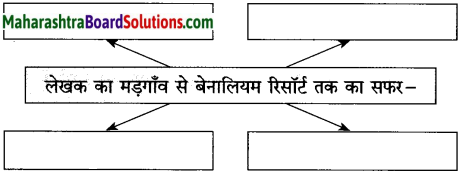
उत्तर:
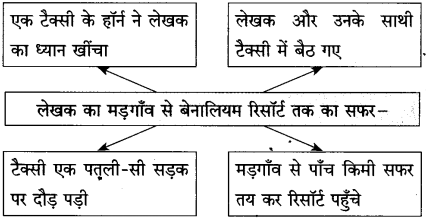
प्रश्न 2.
गलत वाक्यों को सही करके लिखिए:
(i) देश के मध्य में स्थित होने के कारण यह छोटा-सा राज्य प्रत्येक पर्यटक के दिल की धड़कन है।
(ii) शीतल हवा के झोंकों से मन प्रसन्न हो गया और यात्रा की चिंता मिट गई।
उत्तर:
(i) देश के एक कोने में स्थित होने के कारण यह छोटा-सा राज्य प्रत्येक पर्यटक के दिल की धड़कन है।
(ii) शीतल हवा के झोंकों से मन प्रसन्न हो गया और यात्रा की सारी थकान मिट गई।
प्रश्न 3.
संजाल पूर्ण कीजिए: (बोर्ड की नमूना कृतिपत्रिका)

उत्तर:

प्रश्न 4.
एक-दो शब्दों में उत्तर: लिखिए: (बोर्ड की नमूना कृतिपत्रिका)
(i) लेखक का ध्यान अपनी ओर खींचने वाला – [ ]
(ii) समस्याओं से निजात पाने का सबसे अच्छा तरीका – [ ]
(iii) लेखक के सफर का साधन – [ ]
(iv) लेखक के मड़गाँव में पहुँचने का दिन – [ ]
उत्तर:

कृति 2: (आकलन)
प्रश्न 1.
आकृति पूर्ण कीजिए:

उत्तर:
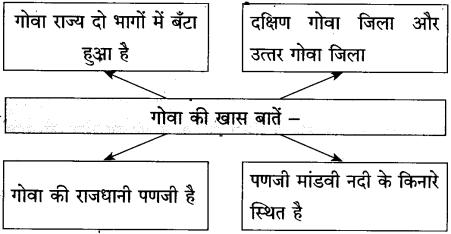
प्रश्न 2.
उत्तर: लिखिए:

उत्तर:

![]()
कृति 3: (शब्द संपदा)
प्रश्न 1.
गद्यांश में प्रयुक्त २ प्रत्यययुक्त शब्द ढूँढकर लिखिए। – (बोर्ड की नमूना कृतिपत्रिका)
(i) _____________
(ii) _____________
उत्तर:
(i) तरंगायित
(ii) प्रत्येक
प्रश्न 2.
निम्नलिखित शब्दों को वर्तनी के नियमानुसार लिखिए:
(i) त्रंगाइत
(ii) आर्कषन
(iii) ओप्चारिक
(iv) खानपुर्ती।
उत्तर:
(i) गाइत -तरंगायित
(ii) आर्कषन -आकर्षण
(iii) ओप्चारिक -औपचारिक
(iv) खानपुर्ती -खानापूर्ति।
प्रश्न 3.
निम्नलिखित शब्दों के विलोम शब्द गद्यांश से ढूँढ़कर लिखिए: (बोर्ड की नमूना कृतिपत्रिका)
(i) अप्रसन्न x _____________
(ii) बुरा x _____________
उत्तर:
(i) अप्रसन्न x प्रसन्न
(ii) बुरा x अच्छा।
कृति 4: (स्वमत अभिव्यक्ति)
प्रश्न.
‘आनंद प्राप्ति का साधन: पर्यटन’ विषय पर अपने विचार 25 से 30 शब्दों में लिखिए। (बोर्ड की नमूना कृतिपत्रिका)
उत्तर:
पर्यटन से हमारे ज्ञान में वृद्धि होती है। किसी स्थान के बारे में पढ़कर जानकारियाँ प्राप्त करने और उसे प्रत्यक्ष देखने में अंतर होता है। यह सुख हमें पर्यटन से प्राप्त होता है। पर्यटन से हमें भिन्नभिन्न प्रदेशों और देशों के प्रसिद्ध स्थलों एवं धरोहरों को देखने का अवसर मिलता है। उनकी संस्कृतियों, उनके रहन-सहन और रीतिरिवाजों को प्रत्यक्ष देखने का मौका मिलता है। इससे हम एक-दूसरे के करीब आते हैं। वहाँ हुए विकास कार्यों से प्रेरणा लेते हैं। इसके अतिरिक्त पर्यटन से अपने रोजमर्रा के कार्यों से कुछ दिन दूर रहने और निश्चित होकर देश-दुनिया को देखने, उससे कुछ सीखने और अपने आप में सुधार करने तथा तनावों से मुक्त रहने का अवसर मिलता है। इस तरह पर्यटन निश्चित रूप से आनंद प्राप्ति का एक सुंदर और मनोरंजक साधन है।
गद्यांश क्र. 2
प्रश्न.
निम्नलिखित पठित गद्यांश पढ़कर दी गई सूचनाओं के अनुसार कृतियाँ कीजिए:
ति 1: (आकलन)
प्रश्न 1.
सही विकल्प चुनकर वाक्य फिर से लिखिए:
(i) गोवा की __________________ बड़ी अच्छी होती है। (सुबह/शाम/रात)
(ii) __________________ सागर देखने का उत्साह बढ़ता जा रहा था। (अरब/हिंद/बंगाल)
(iii) यही __________________ का सत्य भी है। (लोगों/दुनिया/जीवन)
(iv) __________________ सुस्ताने के लिए किनारे पर बैठ जाते हैं। (कुत्ते/पक्षी/लोग)
उत्तर:
(i) गोवा की शाम बड़ी अच्छी होती है।
(ii) अरब सागर देखने का उत्साह बढ़ता जा रहा था।
(iii) यही जीवन का सत्य भी है।
(iv) पक्षी सुस्ताने के लिए किनारे पर बैठ जाते हैं।
प्रश्न 2.
वाक्य पूर्ण कीजिए:
(i) फिर भी धंसे हुए पैरों को __________________
(ii) मानो, लहर कह रही हो कि __________________
उत्तर:
(i) फिर भी धंसे हुए पैरों को पूरी ताकत से उठा-उठाकर भाग रहे थे।
(ii) मानो, लहर कह रही हो कि बनने के बाद मिटना ही नियति है।
![]()
प्रश्न 3.
आकृति पूर्ण कीजिए:
(i) (1) लहरों की आवाज – [ ]
(2) बच्चों से मिली सीख – [ ]
(ii)
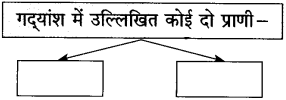
उत्तर:
(i) (1) लहरों की आवाज – रणभेरी जैसी।
(2) बच्चों से मिली सीख – जीवन में आशावाद हो, तो कोई काम असंभव नहीं
(ii)
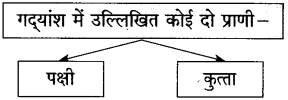
ति 2: (आकलन)
प्रश्न 1.
आकृति पूर्ण कीजिए:
(i) खूबसूरत यह देखते ही मैं उससे जाकर लिपट गया
(ii) बहुत ही खूबसूरत और शांत जगह है यह –
(ii) तभी अचानक इनकी आवाज सुनाई दी
(iv) जल्दी-जल्दी चलने के बाद भी यह तय नहीं हो पा रही थी
उत्तर:
(i) खूबसूरत यह देखते ही मैं उससे जाकर लिपट गया – [समुंदर]
(ii) बहुत ही खूबसूरत और शांत जगह है यह – [बेनालियम]
(iii) तभी अचानक इनकी आवाज सुनाई दी – [लहरों की]
(iv) जल्दी-जल्दी चलने के बाद भी यह तय नहीं हो पा रही थी – [दूरी]
प्रश्न 2.
उत्तर: लिखिए:

उत्तर:
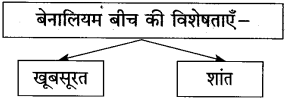
कृति 3: (शब्द संपदा)
प्रश्न 1.
निम्नलिखित शब्दों का वचन बदलकर लिखिए:
(i) हवा
(ii) मछली
(ii) लहर
(iv) बच्चे।
उत्तर:
(i) हवा – हवाएँ
(ii) मछली – मछलियाँ
(iii) लहर – लहरें
(iv) बच्चे – बच्चा
प्रश्न 2.
निम्नलिखित शब्दों के लिंग पहचानकर लिखिए:
(i) जगह
(ii) रेत
(iii) जीवन
(iv) सड़क।
उत्तर:
(i) जगह – स्त्रीलिंग
(ii) रेत – पुल्लिग
(iii) जीवन – पुल्लिंग
(iv) सड़क – स्त्रीलिंग।
![]()
प्रश्न 3.
निम्नलिखित शब्दों के विरुद्धार्थी शब्द लिखिए:
(i) शांत
(ii) मुश्किल
(iii) शाम
(iv) खूबसूरत।
उत्तर:
(i) शांत x अशांत
(ii) मुश्किल x आसान
(iii) शाम x सुबह
(iv) खूबसूरत X बदसूरत।
कृति 4: (स्वमत अभिव्यक्ति)
प्रश्न.
‘गोवा की शाम’ के विषय में अपने विचार लिखिए।
उत्तर:
भारत के पश्चिमी समुद्र तट पर बसे गोवा की खूबसूरती के समान यहाँ की शामें भी अद्भुत होती हैं। जैसे-जैसे शाम होती है, गोवा मस्ती में डूबने लगता है। सागर के तट पर चाँदी जैसी रेत, नीलम जैसा पानी, चर्च, नारियल के पेड़ों का सौंदर्य मन को मोह लेता है। दूर-दूर तक विदेशी सैलानियों की भीड़ दिखाई देती है, कोई उछल रहा है, कोई कूद रहा है, कोई नाच रहा है। बीच पर तरह-तरह के वॉटर स्पोर्ट्स चल रहे हैं।
कहीं मोटरबोट राइडिंग हो रही है, तो कहीं पैराशूट राइडिंग। सैलानियों के लिए क्रूज एक अलग ही आकर्षण होता है। क्रूज अर्थात एक छोटे से स्टीमर में सौ-डेढ़ सौ लोग संगीत की तेज धुन पर थिरकते हुए। यह स्टीमर करीब एक घंटे की घुमावदार परिक्रमा कराता है।
गद्यांश क्र. 3
प्रश्न.
निम्नलिखित पठित गद्यांश पढ़कर दी गई सूचनाओं के अनुसार कृतियाँ कीजिए:
कृति 1: (आकलन)
प्रश्न 1.
जोड़ियाँ मिलाइए:
| ‘अ’ | ‘आ’ |
| (i) मनोरम | फिल्में |
| (ii) युवा | बाजार |
| (iii) हिट | दृश्य |
| (iv) स्थानीय | मस्ती |
उत्तर:
| ‘अ’ | ‘आ |
| (i) मनोरम | दृश्य |
| (ii) युवा | मस्ती |
| (iii) हिट | फिल्में |
| (iv) स्थानीय | बाजार |
प्रश्न 2.
आकृति पूर्ण कीजिए:
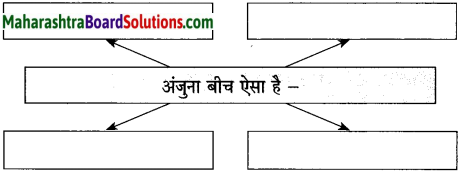
उत्तर:
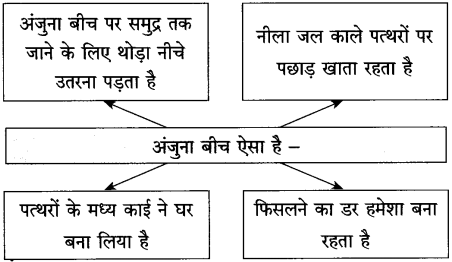
![]()
प्रश्न 3.
संजाल पूर्ण कीजिए:
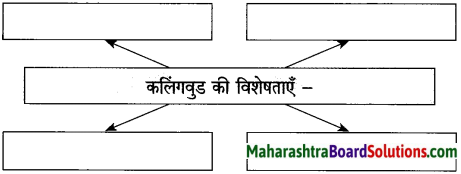
उत्तर:
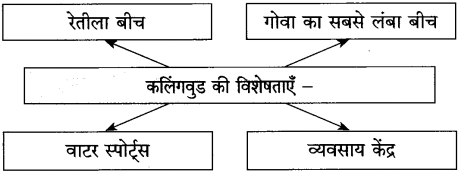
कृति 2: (आकलन)
प्रश्न 1.
विधानों के सामने सत्य/असत्य लिखिए:
(i) पानी नीले पत्थरों पर पछाड़ खाता रहता है।
(ii) पानी ने काट-काटकर पत्थरों में छेद कर दिए हैं।
(iii) गोवा की सारी मछलियाँ निर्यात कर दी जाती हैं।
(iv) हम लोग दिन भर पणजी शहर देखते रहे।
उत्तर:
(i) असत्य
(ii) सत्य
(iii) असत्य
(iv) सत्य।
कृति 3: (शब्द संपदा)
प्रश्न 1.
निम्नलिखित शब्दों के समानार्थी शब्द लिखिए:
(i) समुद्र
(ii) पानी
(iii) पत्थर
(iv) किनारा।
उत्तर:
(i) समुद्र – जलधि
(ii) पानी – सलिल
(iii) पत्थर – पाषाण
(iv) किनारा – तट।
प्रश्न 2.
गद्यांश में प्रयुक्त अंग्रेजी शब्द ढूँढकर लिखिए।
(i) ____________
(ii) ____________
(iii) ____________
(iv) ____________
उत्तर:
(i) शूटिंग
(ii) फिल्म
(iii) बॉलीवुड
(iv) बीच।
![]()
प्रश्न 3.
गद्यांश में प्रयुक्त प्रत्यययुक्त शब्द ढूँढ़कर उनके मूल शब्द और प्रत्यय अलग करके लिखिए।
(i) ____________
(ii) ____________
(iii) ____________
(iv) ____________
उत्तर:
शब्द – मूल शब्द – प्रत्यय
(i) पथरीला – पत्थर – ईला
(ii) पहाड़ी – पहाड़ – ई
(iii) स्थानीय – स्थान – ईय
(iv) व्यावसायिक – व्यवसाय – ई
गद्यांश क्र. 4
प्रश्न.
निम्नलिखित पठित गद्यांश पढ़कर दी गई सूचनाओं के अनुसार कृतियाँ कीजिए:
कृति 1: (आकलन)
प्रश्न 1.
सही विकल्प चुनकर वाक्य फिर से लिखिए:
(i) आप भी अपनी ______________ के अनुसार हाथ आजमा सकते हैं। (इच्छा/जेब/रुचि)
(ii) हम यानी मैं और मेरी ______________ दोनों डर भी रहे थे। (पत्नी/बिटिया/माँ)
(iii) कोलबा बीच पर हमने ______________ मछलियाँ देखीं। (व्हेल/डॉल्फिन/शार्क)
(iv) शाम को भगवान की एक ______________ मंदिर ले जाई जाती है। (मूर्ति/फोटो/पालकी)
उत्तर:
(i) आप भी अपनी रुचि के अनुसार हाथ आजमा सकते हैं।
(ii) हम यानी मैं और मेरी पत्नी दोनों डर भी रहे थे।
(iii) कोलबा बीच पर हमने डॉल्फिन मछलियाँ देखीं।
(iv) शाम को भगवान की एक पालकी मंदिर ले जाई जाती है।
प्रश्न 2.
कारण लिखिए:
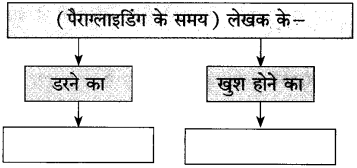
उत्तर:
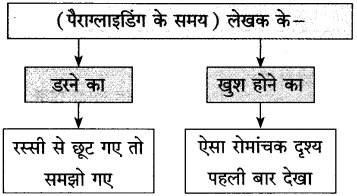
कृति 2: (आकलन)
प्रश्न 1.
संजाल पूर्ण कीजिए:

उत्तर:
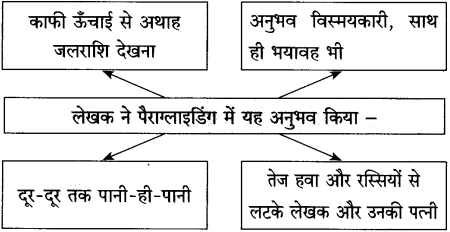
![]()
कृति 3: (शब्द संपदा)
प्रश्न 1.
सोचिए और लिखिए:
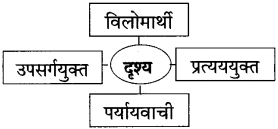
प्रश्न 2.
गद्यांश में प्रयुक्त अंग्रेजी शब्द ढूंढकर लिखिए।
(i) _____________
(ii) _____________
(iii) _____________
(iv) _____________
उत्तर:
(i) बोटिंग
(ii) वॉटर
(iii) स्पोर्ट्स
(iv) पैराग्लाइडिंग।
प्रश्न 3.
गद्यांश में प्रयुक्त शब्द-युग्म ढूँढ़कर लिखिए।
(i) _____________
(ii) _____________
(iii) _____________
(iv) _____________
उत्तर:
(i) रचा-बसा
(ii) अपनी-अपनी
(iii) एक-दूसरे
(iv) घूमना-फिरना।
कृति 4: (स्वमत अभिव्यक्ति)
प्रश्न.
‘गोवा की संस्कृति’ के विषय में 25 से 30 शब्दों में अपने विचार लिखिए।
उत्तर:
सुरम्य सागरतट पर बसा गोवा प्रांत अपनी प्राकृतिक सुंदरता और अनूठी संस्कृति के लिए प्रसिद्ध है। यहाँ की संस्कृति काफी प्राचीन है। आजादी से पहले गोवा पुर्तगाल और फ्रांस का उपनिवेश था। इस वजह से आज भी यहाँ के रहन-सहन, खान-पान पर पश्चिमी संस्कृति का पूरा प्रभाव दिखाई देता है। यहाँ लगभग 80 प्रतिशत लोग ईसाई हैं।
गोवा की एक खास बात यह है कि यहाँ के ईसाई समाज में भी हिंदुओं जैसी जाति व्यवस्था पाई जाती है। दक्षिण गोवा में ईसाई समाज का प्रभाव अधिक है, लेकिन वहाँ के वास्तुशास्त्र में हिंदू प्रभाव दिखाई देता है। गोवा में अत्यंत प्राचीन मंदिर पाए जाते हैं, जबकि उत्तर: गोवा में पुर्तगाली वास्तुकला के नमूने ज्यादा दृष्टिगोचर होते हैं।
![]()
भाषा अध्ययन (व्याकरण)
प्रश्न.
सूचनाओं के अनुसार कृतियाँ कीजिए:
1. शब्द भेद:
अधोरेखांकित शब्दों का शब्दभेद पहचानकर लिखिए:
(i) मैं उनसे पूछने लगा।
(ii) हम मड़गाँव 23 नवंबर को पहुंचे।
उत्तर:
(i) उनसे – पुरुषवाचक सर्वनाम।
(ii) मड़गाँव – व्यक्तिवाचक संज्ञा।
2. अव्यय:
निम्नलिखित अव्ययों का अपने वाक्यों में प्रयोग कीजिए:
(i) वहाँ
(ii) कभी-कभी।
उत्तर:
(i) वहाँ! एक मजेदार दृश्य देखने को मिला।
(ii) कभी-कभी कोई जल-पक्षी कुत्तों का शिकार बन जाता है।
3. संधि:
कृति पूर्ण किजिए:
| संधि शब्द | संधि विच्छेद | संधि भेद |
| स्वच्छ | ___________ | ___________ |
| अथवा | ||
| सत् + आचार | ___________ | ___________ |
उत्तर:
| संधि शब्द | संधि विच्छेद | संधि भेद |
| स्वच्छ | सु + अच्छ | स्वर संधि |
| अथवा | ||
| सदाचार | सत् + आचार | व्यंजन संधि |
4. सहायक क्रिया:
निम्नलिखित वाक्यों में से सहायक क्रियाएँ पहचानकर उनका मूल रूप लिखिए:
(i) हम सभी समुद्र की ओर दौड़ पड़े।
(ii) हम दिन भर पणजी शहर देखते रहे।
उत्तर:
सहायक क्रिया – मूल रूप
(i) पड़े – पड़ना
(i) रहे – रहना
![]()
5. प्रेरणार्थक क्रिया:
निम्नलिखित क्रियाओं के प्रथम प्रेरणार्थक और द्वितीय प्रेरणार्थक रूप लिखिए:
(i) सुनना
(ii) बनना
(iii) झुकना।
उत्तर:
| क्रिया | प्रथम प्रेरणार्थक रूप | द्वितीय प्रेरणार्थक रूप |
| (i) सुनना | सुनाना | सुनवाना |
| (ii) बनना | बनाना | बनवाना |
| (iii) झुकना | झुकाना | झुकवाना |
6. मुहावरे:
(1) निम्नलिखित मुहावरों का अर्थ लिखकर वाक्य में प्रयोग कीजिए:
(i) शिकार होना
(ii) दीवार टूट जाना।
उत्तर:
(i) शिकार होना।
अर्थ: पीड़ित होना।
वाक्य: पुराने जमाने में न जाने कितने गरीब जींदारों के अत्याचारों के शिकार हो जाते थे।
(ii) दीवार टूट जाना।
अर्थ: अड़चन समाप्त हो जाना।
वाक्य: स्त्रियों को समानता का अधिकार मिल जाने से सभी स्त्री-पुरुष के बीच असमानता की दीवार टूट गई।
(2) अधोरेखांकित वाक्यांश के लिए कोष्ठक में दिए गए उचित मुहावरे का चयन करके वाक्य फिर से लिखिए: (कान पक जाना, भनक पड़ना, कान पकड़ना) थानेदार ने उड़ती हुई बात सुनी कि गाँव में डाकू आने वाले हैं।
उत्तर:
भनक पड़ना। वाक्य: थानेदार के कान में भनक पड़ी कि गाँव में डाकू आने वाले हैं।
7. कारक:
निम्नलिखित वाक्यों में प्रयुक्त कारक पहचानकर उनका भेद ‘लिखिए:
(i) गोवा की मांडवी नदी वर्ष भर पानी से भरी रहती है।
(ii) गोवा राज्य दो भागों में बँटा हुआ है।
उत्तर:
(i) पानी से-करण कारक।
(ii) भागों में-अधिकरण कारक।
8. विरामचिह्न:
निम्नलिखित वाक्यों में यथास्थान उचित विरामचिह्नों का प्रयोग करके वाक्य फिर से लिखिए:
(i) दूर दूर तक पानी ही पानी तेज हवा और रस्सियों से हवा में लटके हम
(ii) गोवा यह नाम सुनते ही सभी का मन तरंगायित हो उठता है और हो भी क्यों न यहाँ की प्रकृति आबोहवा जीवनशैली ही ऐसी है
उत्तर:
(i) दूर-दूर तक पानी-ही-पानी, तेज हवा और रस्सियों से हवा में लटके हम।
(ii) गोवा ! यह नाम सुनते ही सभी का मन तरंगायित हो उठता है और हो भी क्यों न, यहाँ की प्रकृति, आबोहवा जीवनशैली ही ऐसी है।
![]()
9. काल परिवर्तन:
निम्नलिखित वाक्यों का सूचना के अनुसार काल परिवर्तन कीजिए:
(i) मंत्री जी ने लोगों को एक मशवरा दिया। (पूर्ण वर्तमानकाल)
(ii) गोवा में मुझे मेरे पुराने अध्यापक मिले थे। (सामान्य भूतकाल)
उत्तर:
(i) मंत्री जी ने लोगों को एक मशवरा दिया है।
(ii) गोवा में मुझे मेरे पुराने अध्यापक मिले।
10. वाक्य भेद:
(1) रचना के आधार पर निम्नलिखित वाक्यों का भेद पहचानकर लिखिए:
(i) सबकी अपनी-अपनी सांस्कृतिक परंपरा है।
(ii) डॉल्फिन मछलियाँ छोटी थीं पर बच्चों को आनंद आया।
उत्तर:
(i) सरल वाक्य
(ii) संयुक्त वाक्य।
(2) निम्नलिखित वाक्यों का अर्थ के आधार पर दी गई सूचना के अनुसार परिवर्तन कीजिए:
(i) पर्यटन का अपना ही आनंद है। (विस्मयवाचक)
(ii) आशावाद हो तो हर काम संभव है। (निषेधवाचक)
उत्तर:
(i) वाह! पर्यटन का अपना ही आनंद है।
(ii) आशावाद हो तो कोई काम असंभव नहीं है।
11. वाक्य शुद्धिकरण:
निम्नलिखित वाक्य शुद्ध करके लिखिए:
(i) भाषा ईश्वर का बड़ा देन है।
(ii) पैसेवाली व्यक्ति कटु बोलती है।
उत्तर:
(i) भाषा ईश्वर की बड़ी देन है।
(ii) पैसेवाला व्यक्ति कटु बोलता है।
उपक्रम/कृति/परियोजना
प्रश्न.
गोवा की ऐतिहासिक पृष्ठभूमि की जानकारी पदिए और कालानुक्रम के अनुसार प्रमुख घटनाओं की तालिका बनाइए।
उत्तर:
गोवा की ऐतिहासिक पृष्ठभूमि:
| मौर्य वंश | तीसरी सदी ईसा पूर्व से पहली सदी तक |
| कोल्हापुर के सातवाहन | पहली सदी से 580 ईसवी तक |
| बादामी के चालुक्य | 580 ईसवी से 750 ईसवी तक |
| विजयनगर | 1312 ईसवी सें1468 तक |
| दिल्ली सल्तनत | 1469 ईसवी से 1510 ईसवी तक |
| पुर्तगाली शासन | 1510 ईसवी से 1960 ईसवी तक |
![]()
प्रश्न.
गोवा की प्राकृतिक सुंदरता पर संवाद प्रस्तुत कीजिए।
उत्तर:
गोवा की प्राकृतिक सुंदरता पर दो सहेलियों के बीच संवाद:
रुचि: नीनू, बहुत दिनों बाद दिखी। कैसी हो? कहीं बाहर गई थी क्या?
नीनू: हाँ रुचि, हम लोग एक सप्ताह के लिए गोवा गए थे।
रुचि: गोवा! नीनू मैंने सुना है कि गोवा बहुत सुंदर है।
नीनू: सच सुना है रुचि। गोवा इतना सुंदर है कि मेरा तो मन करता था कि वहाँ से वापस ही नहीं आऊँ।
रुचि: मुझे भी तो कुछ बताओ।
नीनू: रुचि, गोवा अपने समुद्र तटों के लिए बहुत प्रसिद्ध है। साफ नीला पानी, लंबे समुद्र तट, चमचमाती रेत और नारियल के वृक्ष यहाँ की विशेषता है। गोवा में इतनी अधिक हरियाली है कि ऐसा लगता है मानो घरती ने हरी चादर ओढ़ रखी है।
रुचि: ओह! सुनकर ही कितना अच्छा लग रहा है।
नीनू: गोवा के लोग प्रकृति से बहुत प्रेम करते हैं। छोटे-से छोटे घर के आगे भी सुंदर-सुंदर फूल-पौधे जरूर होते हैं। वहाँ बड़ा शांत और मनोरंजक वातावरण है।
रुचि: गोवा के समुद्र तट के बारे में कुछ और बताओ न।
नीनू: वहाँ सागर से आसमान देखकर लगता है मानो नीला आसमान पानी से मिल रहा है। प्रातःकाल में उगता हुआ सूरज ऐसा लगता है, मानो समुद्र में से ही उग रहा हो। इसी तरह सूर्यास्त के समय सूरज का लाल गोला धीरे-धीरे नीचे जाता हुआ अचानक समुद्र में डूबता-सा लगता है। जैसे-जैसे शाम होती है, समुद्र की लहरों का ऊँचा उठन्य शुरू हो जाता है।
गोवा जैसा मैंने देखा Summary in Hindi
गोवा जैसा मैंने देखा विषय–प्रवेश :
प्रस्तुत यात्रा निबंध में विनय शर्मा ने भारत के पश्चिमी तट पर बसे गोवा की प्राकृतिक सुंदरता, वहाँ के लोगों की जीवन शैली, त्योहारों तथा समुद्र तटों का मनोरम, मनोहारी चित्रण किया है। यहाँ के समुद्र तट पर्यटकों के आकर्षण के केंद्र बिंदु हैं। पश्चिमी फैशन के साथ अपने आप को ढालते हुए भी गोवा अपनी भारतीय परंपरा और सभ्यता को नहीं भूला है।
गोवा जैसा मैंने देखा मुहावरे – अर्थ
- मन तरंगायित होना – मन उमंग से भरना।
- निजात पाना – मुक्ति पाना।
- दो – चार होना – जूझना।
- जेब ढीली होना – जेब खाली होना, बहुत खर्च होना।
Hindi Lokbharti 10th Std Digest पहली इकाई
- भारत महिमा Question Answer
- लक्ष्मी Question Answer
- Chapter 3 वाह रे! हमदर्द Question Answer
- मन Question Answer (पूरक पठन)
- गोवा : जैसा मैंने देखा Question Answer
- गिरिधर नागर Question Answer
- खुला आकाश Question Answer (पूरक पठन)
- गजल Question Answer
- रीढ़ की हड्डी Question Answer
- ठेस Question Answer (पूरक पठन)
- कृषक गान Question Answer
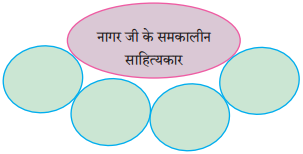
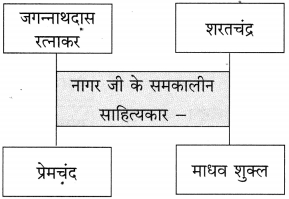



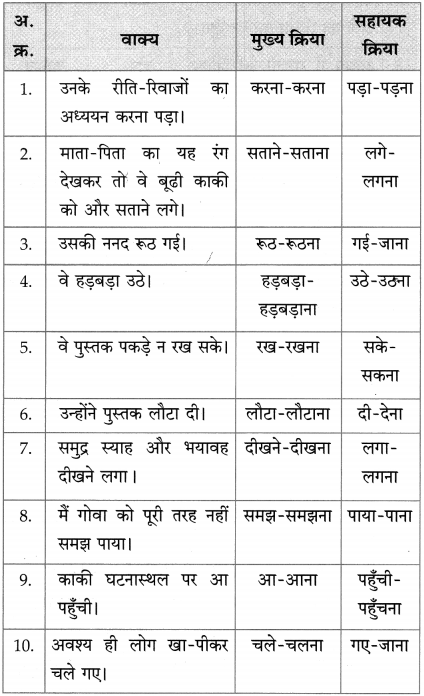

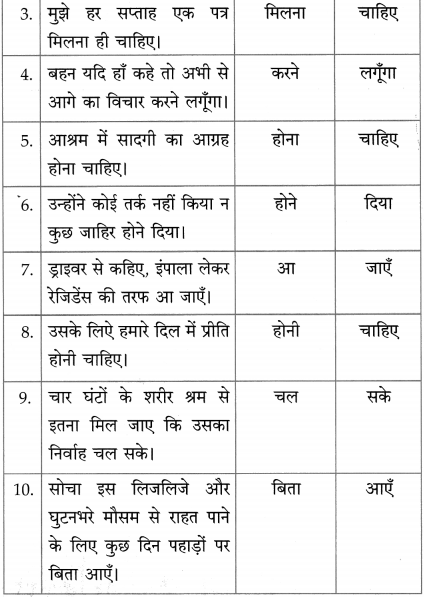
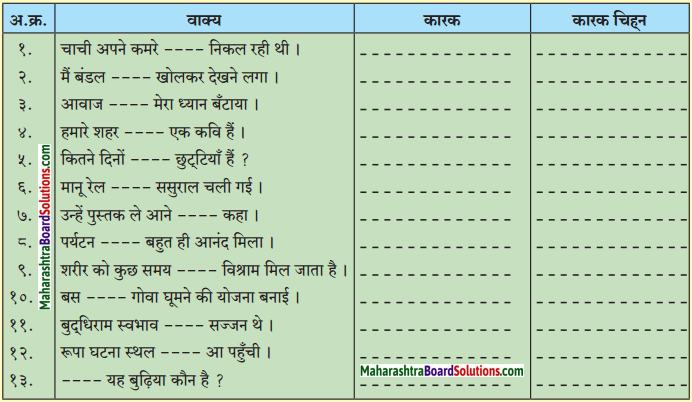
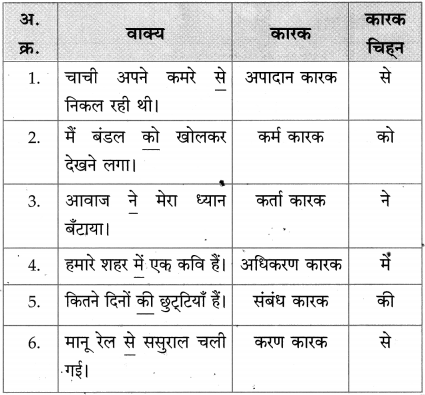
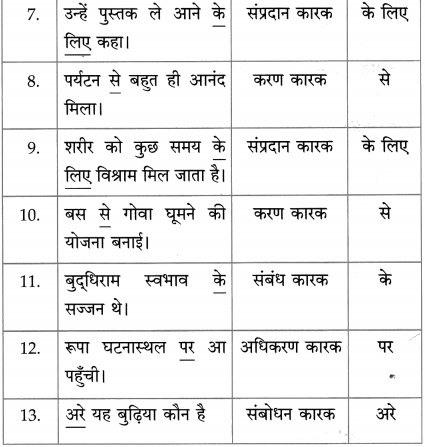
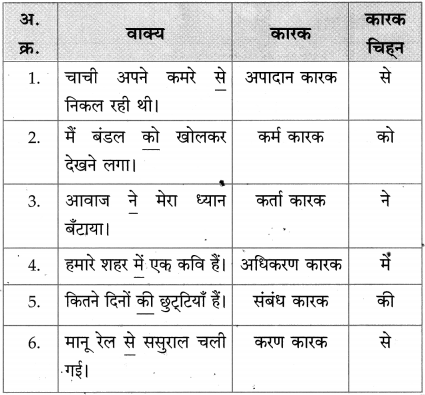
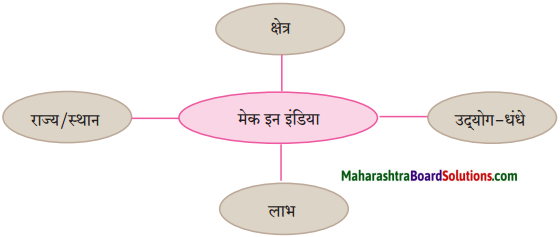


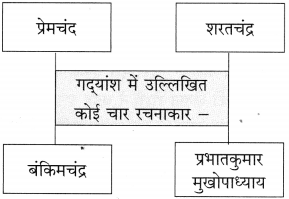
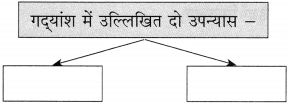
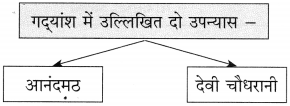
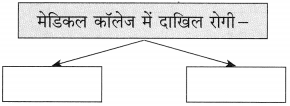
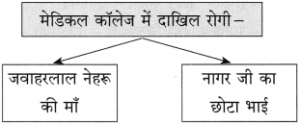
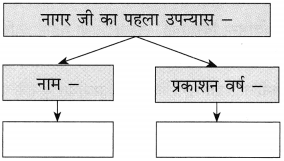
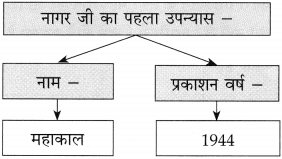
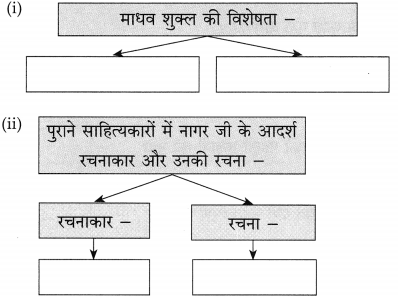
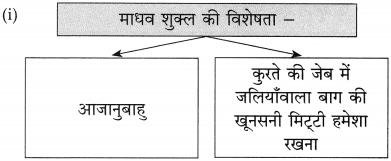






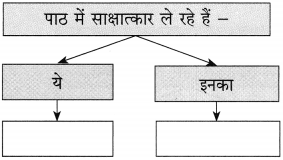
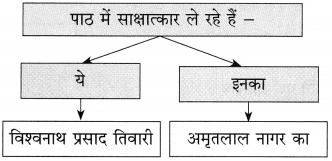

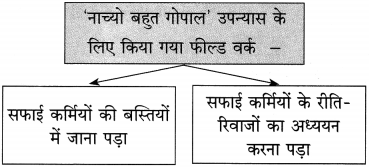
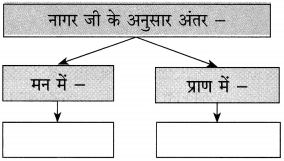
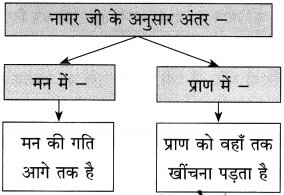
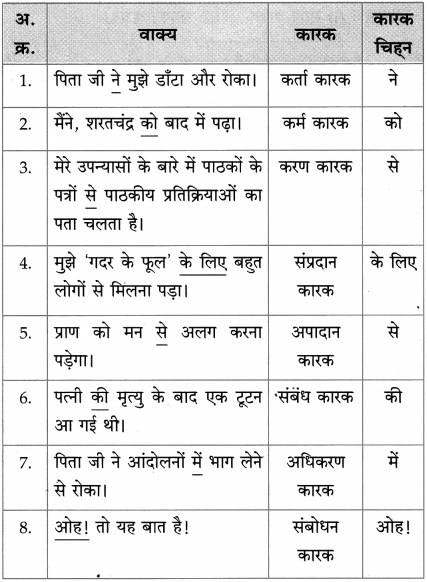


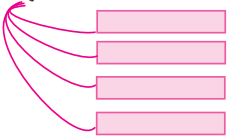

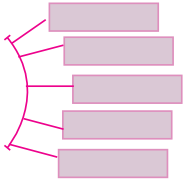

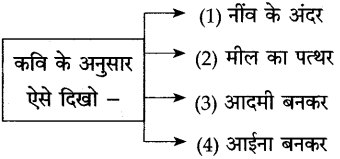

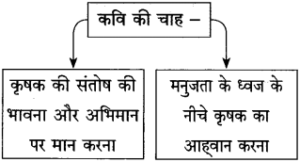




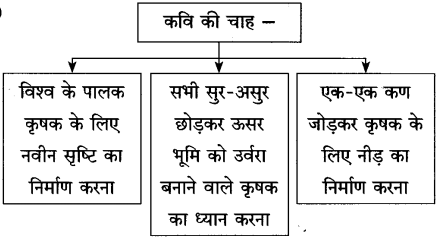
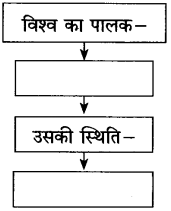
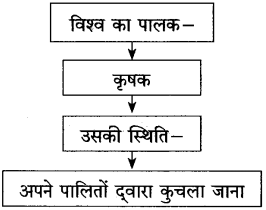


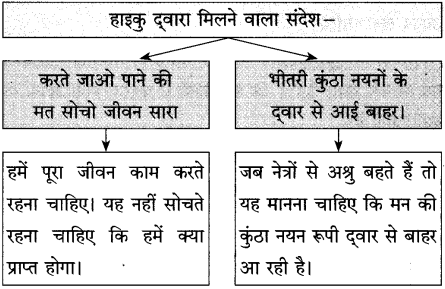
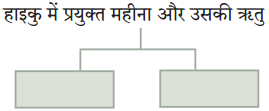


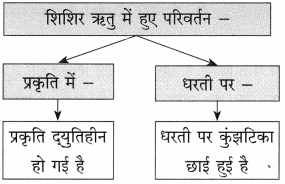
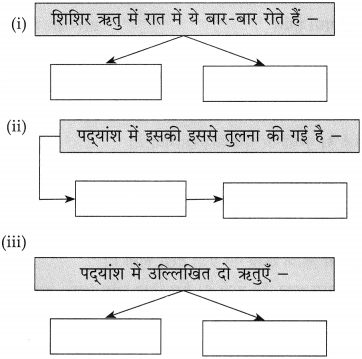
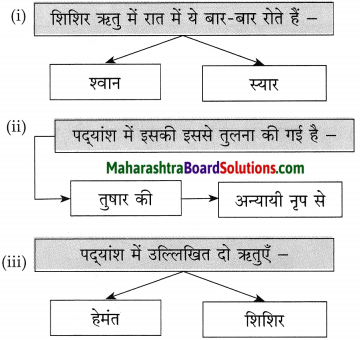
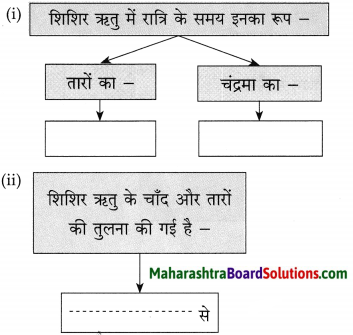
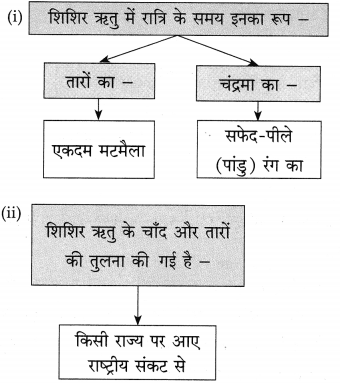
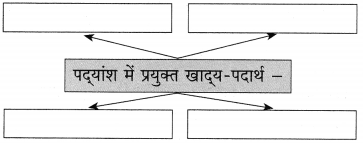
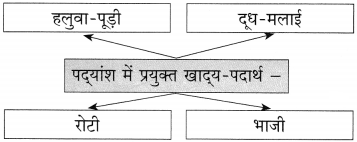
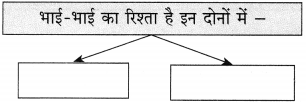

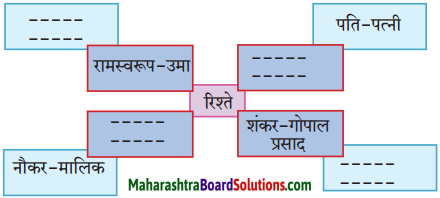
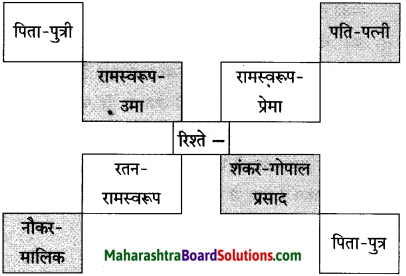



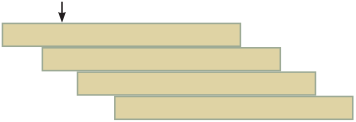
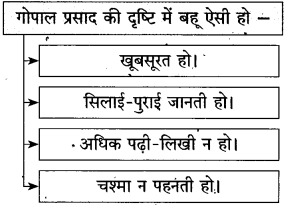
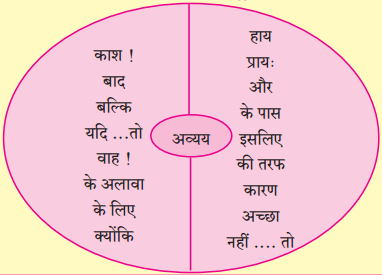


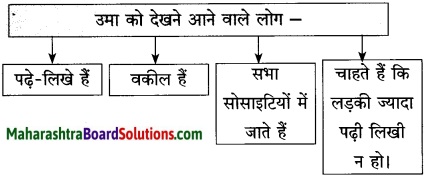
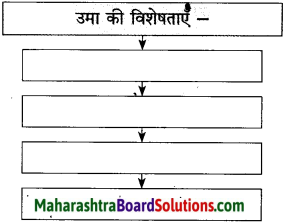
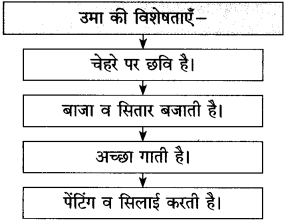
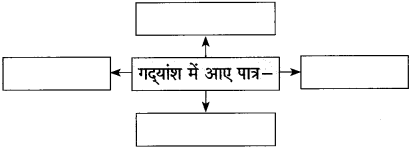
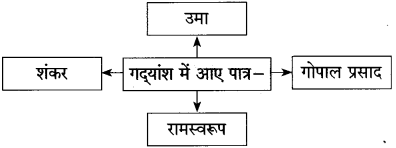
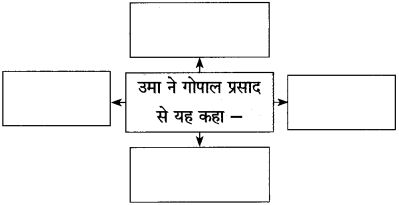
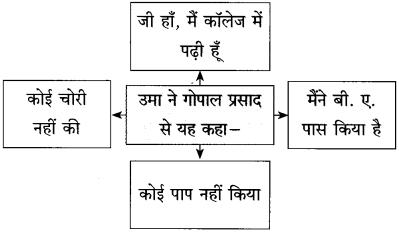
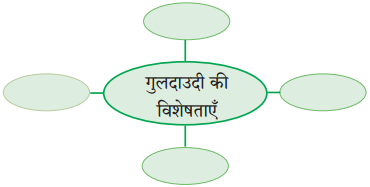
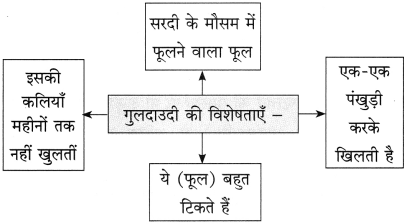
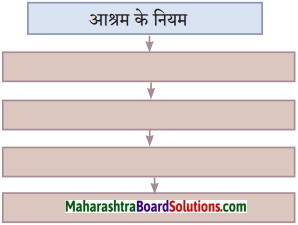
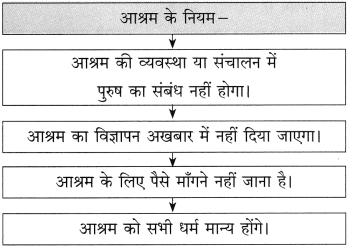
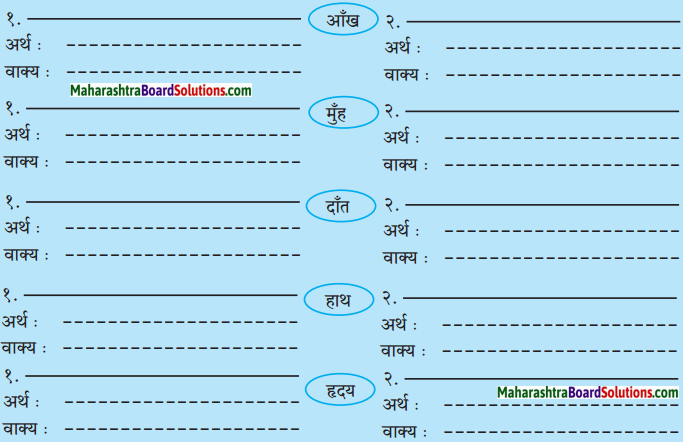
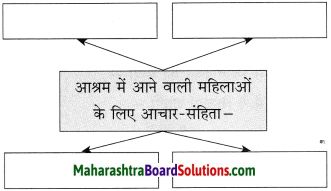
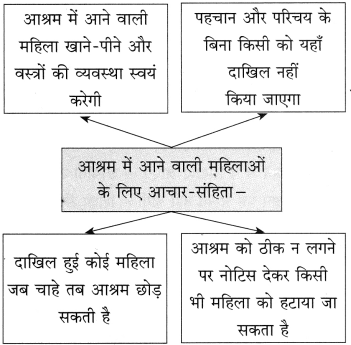
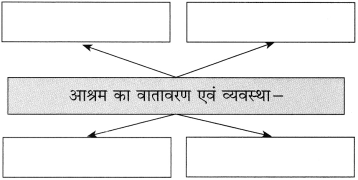
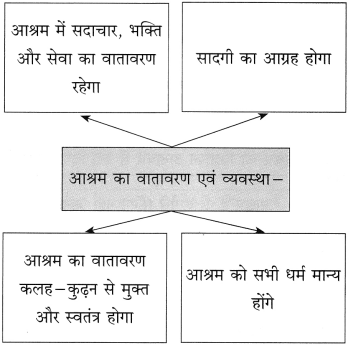

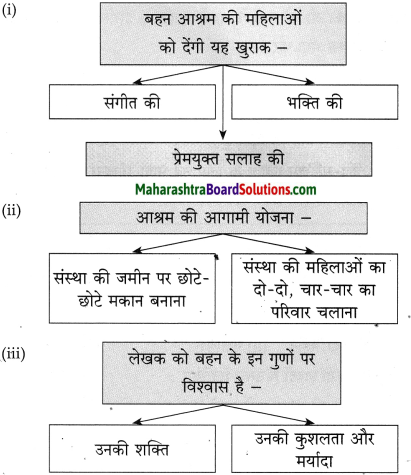



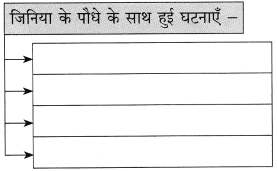
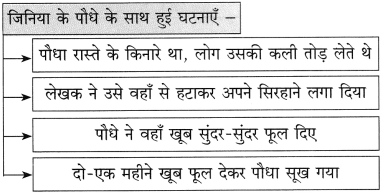
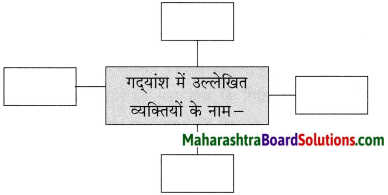

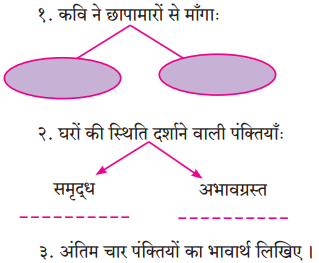 उत्तर:
उत्तर:  (ii)
(ii) 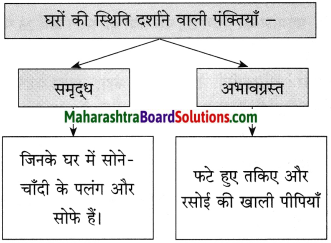 प्रश्न 2. संजाल पूर्ण कीजिए:
प्रश्न 2. संजाल पूर्ण कीजिए: 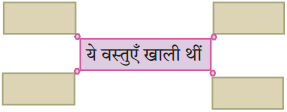 उत्तर:
उत्तर: 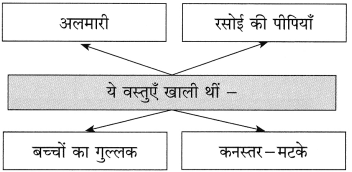 प्रश्न 2. कृति पूर्ण कीजिए:
प्रश्न 2. कृति पूर्ण कीजिए:  उत्तर:
उत्तर: 
 प्रश्न 3. कविता के आधार पर जोड़ियाँ मिलाइए: अ – आ अर्थ – बालों में सुवर्ण – चेहरे पर चाँदी – नई कविता में मुद्रा – काव्य कृतियों में उत्तर: (i) अर्थ – नई कविता में (ii) सुवर्ण – काव्य कृतियों में (iii) चाँदी – बालों में (iv) मुद्रा – चेहरे पर। प्रश्न 4. प्रवाह तालिका पूर्ण कीजिए:
प्रश्न 3. कविता के आधार पर जोड़ियाँ मिलाइए: अ – आ अर्थ – बालों में सुवर्ण – चेहरे पर चाँदी – नई कविता में मुद्रा – काव्य कृतियों में उत्तर: (i) अर्थ – नई कविता में (ii) सुवर्ण – काव्य कृतियों में (iii) चाँदी – बालों में (iv) मुद्रा – चेहरे पर। प्रश्न 4. प्रवाह तालिका पूर्ण कीजिए: 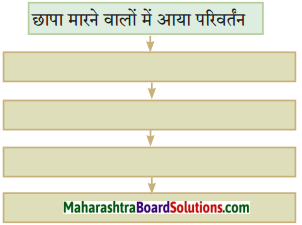 उत्तर:
उत्तर: 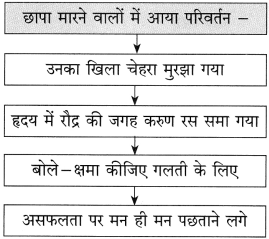 प्रश्न 5. ऐसे प्रश्न बनाइए जिनके उत्तर निम्न शब्द हों a. अरण्यकांड b. तख्त c. असफलता d. अनधिकृत उत्तर: a. कवि के घर में क्या देखकर छापा मारने वालों का खिला चेहरा मुरझा गया? b. कवि छापा मारने वालों से अपने घर में क्या डलवाने के लिए कहते हैं? c. कवि के घर छापा मारने पर छापा मारने वालों को क्या मिली? d. छापा मारने वालों को लेखक से किस प्रकार का अर्थ चाहिए था? प्रश्न 6. सोना, चाँदी, अर्थ और मुद्रा इन शब्दों के विभिन्न अर्थ बताते हुए कविता के आधार पर इनके अर्थ लिखिए। उत्तर:
प्रश्न 5. ऐसे प्रश्न बनाइए जिनके उत्तर निम्न शब्द हों a. अरण्यकांड b. तख्त c. असफलता d. अनधिकृत उत्तर: a. कवि के घर में क्या देखकर छापा मारने वालों का खिला चेहरा मुरझा गया? b. कवि छापा मारने वालों से अपने घर में क्या डलवाने के लिए कहते हैं? c. कवि के घर छापा मारने पर छापा मारने वालों को क्या मिली? d. छापा मारने वालों को लेखक से किस प्रकार का अर्थ चाहिए था? प्रश्न 6. सोना, चाँदी, अर्थ और मुद्रा इन शब्दों के विभिन्न अर्थ बताते हुए कविता के आधार पर इनके अर्थ लिखिए। उत्तर:  प्रश्न 7. कर जमा करना, देश के विकास को गति देना हैं’ विषय पर अपने विचार लिखिए। उत्तर: समाज में दो तरह के लोग होते हैं। एक वे, जो कर अदा करने लायक आय होने पर स्वेच्छा से ईमानदारी के साथ सरकार को कर अदा | कर देते हैं और दूसरे वे, जो कमाई तो जायज-नाजायज अंधाधुंध करते हैं, पर नियम के तहत कर अदा करने से कतराते हैं। यह मनोवृत्ति उचित नहीं है। देश के विकास का कार्य जनता द्वारा प्राप्त कर से ही पूरा होता है। चिकित्सा, परिवहन तथा जनता की सहायतार्थ शुरू किए जाने वाले सारे कार्य जनता से प्राप्त कर से ही पूरे होते हैं। जिस देश में आय करने वाले सभी लोग ईमानदारी और स्वेच्छा से उचित मात्रा में कर अदा करते हैं, उस देश के विकास के सारे कार्य सुचारू रूप से पूरे होते हैं और सामान्य जनता को उसका पूरा-पूरा लाभ मिलता है। यदि कोई व्यक्ति यह सोचता हो कि सभी लोग तो कर अदा करते हैं, उसके अकेले कर अदा न करने या कम कर का भुगतान करने से क्या फर्क पड़ेगा, ‘तो ऐसा सोचने वालों की संख्या अनगिनत हो सकती है। इस तरह कर की कितनी रकम सरकारी खजाने में जमा होने से रह जाती है। इस कारण पैसे के अभाव में सरकार की अनेक योजनाएँ अटकी रह जाती हैं। इसलिए कर योग्य आय पर ईमानदारी से कर जमा करना प्रत्येक नागरिक का कर्तव्य है। कर अदा कर हम अपनी ही सहायता करते हैं। कर जमा करने से ही विकास को गति मिलती है।
प्रश्न 7. कर जमा करना, देश के विकास को गति देना हैं’ विषय पर अपने विचार लिखिए। उत्तर: समाज में दो तरह के लोग होते हैं। एक वे, जो कर अदा करने लायक आय होने पर स्वेच्छा से ईमानदारी के साथ सरकार को कर अदा | कर देते हैं और दूसरे वे, जो कमाई तो जायज-नाजायज अंधाधुंध करते हैं, पर नियम के तहत कर अदा करने से कतराते हैं। यह मनोवृत्ति उचित नहीं है। देश के विकास का कार्य जनता द्वारा प्राप्त कर से ही पूरा होता है। चिकित्सा, परिवहन तथा जनता की सहायतार्थ शुरू किए जाने वाले सारे कार्य जनता से प्राप्त कर से ही पूरे होते हैं। जिस देश में आय करने वाले सभी लोग ईमानदारी और स्वेच्छा से उचित मात्रा में कर अदा करते हैं, उस देश के विकास के सारे कार्य सुचारू रूप से पूरे होते हैं और सामान्य जनता को उसका पूरा-पूरा लाभ मिलता है। यदि कोई व्यक्ति यह सोचता हो कि सभी लोग तो कर अदा करते हैं, उसके अकेले कर अदा न करने या कम कर का भुगतान करने से क्या फर्क पड़ेगा, ‘तो ऐसा सोचने वालों की संख्या अनगिनत हो सकती है। इस तरह कर की कितनी रकम सरकारी खजाने में जमा होने से रह जाती है। इस कारण पैसे के अभाव में सरकार की अनेक योजनाएँ अटकी रह जाती हैं। इसलिए कर योग्य आय पर ईमानदारी से कर जमा करना प्रत्येक नागरिक का कर्तव्य है। कर अदा कर हम अपनी ही सहायता करते हैं। कर जमा करने से ही विकास को गति मिलती है। 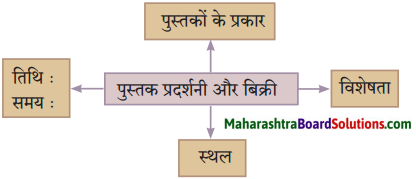 उत्तर:
उत्तर: 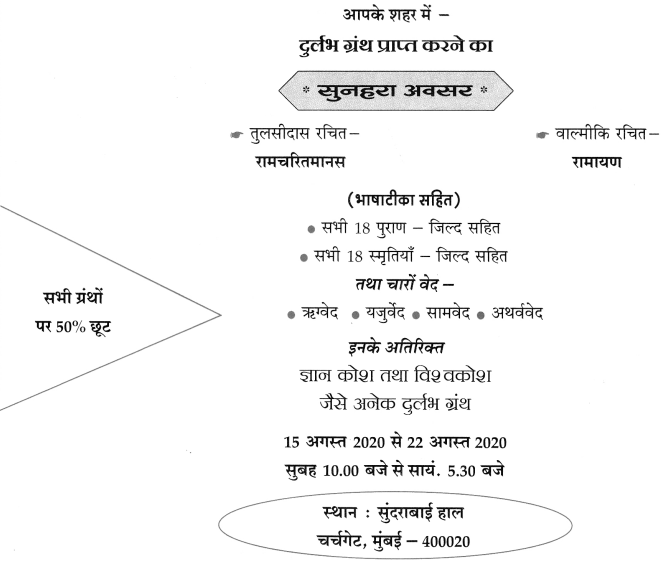 Hindi Lokbharti 10th Textbook Solutions Chapter 4 छापा Additional Important Questions and Answers
Hindi Lokbharti 10th Textbook Solutions Chapter 4 छापा Additional Important Questions and Answers 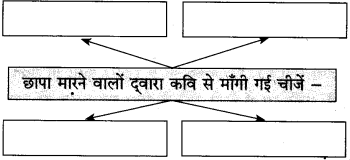 उत्तर:
उत्तर:  प्रश्न 2. निम्नलिखित प्रश्नों के उत्तर लिखिए: (i) वे (छापा मारने वाले) रोष से बोले तो कवि किस प्रकार बोले? (ii) वे (छापा मारने वाले) कड़ककर बोले तो कवि किस प्रकार बोले? उत्तर: (i) वे रोष से बोले तो कवि जोश से बोले। (ii) वे कड़ककर बोले तो कवि भड़ककर बोले। प्रश्न 3. संजाल पूर्ण कीजिए:
प्रश्न 2. निम्नलिखित प्रश्नों के उत्तर लिखिए: (i) वे (छापा मारने वाले) रोष से बोले तो कवि किस प्रकार बोले? (ii) वे (छापा मारने वाले) कड़ककर बोले तो कवि किस प्रकार बोले? उत्तर: (i) वे रोष से बोले तो कवि जोश से बोले। (ii) वे कड़ककर बोले तो कवि भड़ककर बोले। प्रश्न 3. संजाल पूर्ण कीजिए: 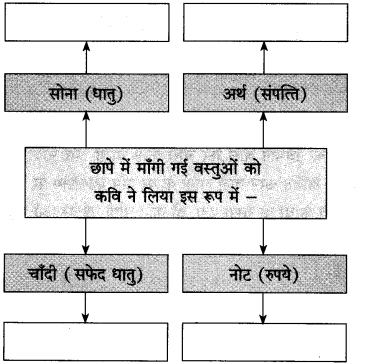 उत्तर:
उत्तर: 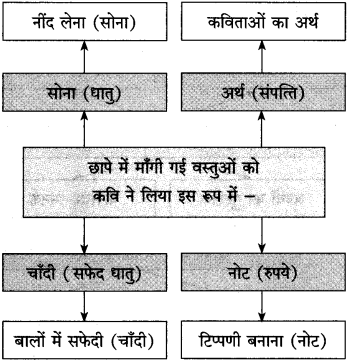 प्रश्न 4. कविता के आधार पर जोड़ियाँ मिलाइए: अ – आ अर्थ – बालों में सुवर्ण – चेहरे पर चाँदी – नई कविता में मुद्रा – काव्य कृतियों में
प्रश्न 4. कविता के आधार पर जोड़ियाँ मिलाइए: अ – आ अर्थ – बालों में सुवर्ण – चेहरे पर चाँदी – नई कविता में मुद्रा – काव्य कृतियों में 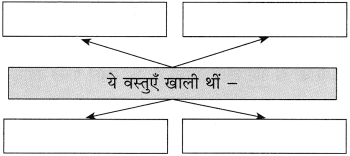 प्रश्न 2. आकृति पूर्ण कीजिए:
प्रश्न 2. आकृति पूर्ण कीजिए: 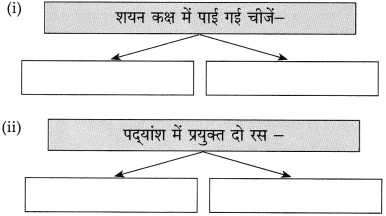 उत्तर:
उत्तर: 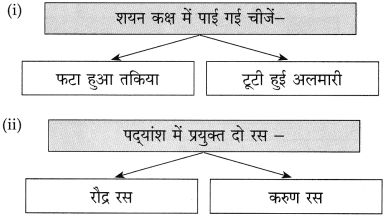 प्रश्न 3. ऐसे प्रश्न बनाइए जिनके उत्तर निम्नलिखित शब्द हों: (i) मुद्रा (ii) शयन कक्ष। उत्तर: (i) कवि ने छापा मारने वालों से अपने मुँह पर क्या देखने के लिए कहा? (ii) छापा मारने वाले कहाँ घुस गए? प्रश्न 4. आकृति पूर्ण कीजिए:
प्रश्न 3. ऐसे प्रश्न बनाइए जिनके उत्तर निम्नलिखित शब्द हों: (i) मुद्रा (ii) शयन कक्ष। उत्तर: (i) कवि ने छापा मारने वालों से अपने मुँह पर क्या देखने के लिए कहा? (ii) छापा मारने वाले कहाँ घुस गए? प्रश्न 4. आकृति पूर्ण कीजिए: 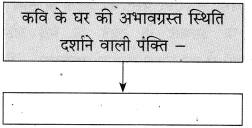 उत्तर:
उत्तर: 
 उत्तर:
उत्तर: 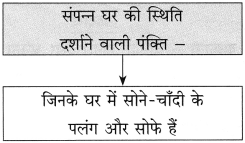 प्रश्न 2. संजाल पूर्ण कीजिए:
प्रश्न 2. संजाल पूर्ण कीजिए: 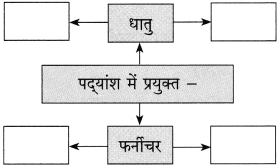 उत्तर:
उत्तर:  प्रश्न 3. ऐसे प्रश्न तैयार कीजिए, जिनके अर्थ निम्नलिखित शब्द हों: (i) पलंग (ii) धन। उत्तर: (i) परिच्छेद में सोफे के अलावा सोने-चाँदी से बनी और किस वस्तु का उल्लेख हुआ है? (ii) कवि के घर में क्या बिलकुल नहीं है?
प्रश्न 3. ऐसे प्रश्न तैयार कीजिए, जिनके अर्थ निम्नलिखित शब्द हों: (i) पलंग (ii) धन। उत्तर: (i) परिच्छेद में सोफे के अलावा सोने-चाँदी से बनी और किस वस्तु का उल्लेख हुआ है? (ii) कवि के घर में क्या बिलकुल नहीं है? 